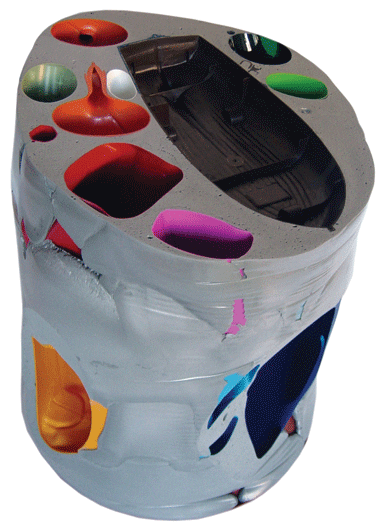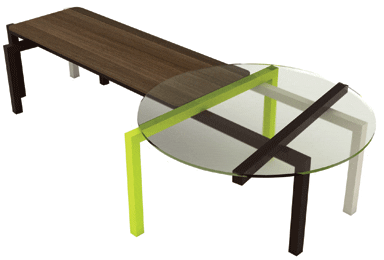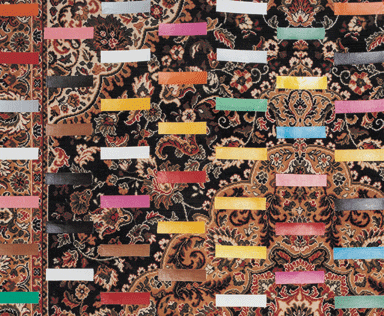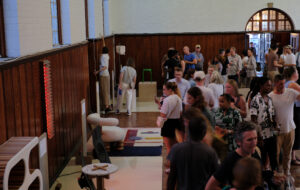
words William Wiles + Anna Bates
It’s a word with nothing but negative associations: repellent, mutant, nasty. On the surface, it’s the enemy of design. It stands for formlessness over form; artlessness over artistry; revulsion over delight; randomness and chaos in place of craft and precision. But it’s also magnetic.
Many of the most interesting things we saw at the Milan furniture fair this year were quite ugly. More and more designers are rejecting the norms of aesthetic good taste and challenging us with the impolite and the imperfect. Ugly is a rebellion. It can be the foundations of a wholly new aesthetic.
“In a way, it’s a reaction to slick design,” says Bertjan Pot, the young Dutch designer who made our ugly cover. “Ugliness can make you think – if you go too beautiful it can stop you from thinking.”
“What ugliness or rawness can bring is a kind of vitality back to design,” says Berlin-based designer Jerszy Seymour, who has deliberately striven towards ugliness as part of his practice – in particular Scum, a series of works made by dribbling and pouring a kind of expanding foam usually used as insulation.
Scum is among the works gathered together by Sebastian Hackenschmidt, curator of furniture at MAK in Vienna, for an exhibition of formlessness in design that opened in May. Formless Furniture charts the ascent of a particular kind of ugliness in design – the blob. One designer in particular dominates this show: Gaetano Pesce, the New York-based veteran artist and designer, who has spent a 40-year career happily defying conventional notions of good taste, producing a body of work that is rarely popular, often ugly, and always provocative and interesting.
“We want something human [in design],” says Pesce. “And the only way is to introduce the ‘badly done’ into things. The bad realisation, the version with mistakes, it gives the object a soul. And at that moment, what we were calling ugly, it becomes beautiful because it’s carrying human qualities that abstract beauty cannot carry.”
One of the most impressive things about Pesce’s body of work is its creative variety. As an aesthetic, ugly is perhaps more diverse than beauty. It can be the blobby, formless creations that fascinate Seymour and Hackenschmidt. But there’s also an ugliness to uncomfortable hybrids, an ugliness directly referred to by London-based design studio El Ultimo Grito when they called their collection of cut-up furniture “Dr Moreau”, after Jules Verne’s mad scientist who created grotesque human-animal hybrids. There’s an ugliness in taking an existing piece of conventionally attractive furnishing and deliberately “spoiling” it, as Pot does when he adds duct tape and bubble gum to antique rugs. There’s an ugliness to deliberately making something in a slapdash or random way, as Dutch designer Maarten Baas does when he moulds clay chairs with his fingers. There’s an ugliness in synthetic materials like flesh-coloured rubber, which London-based duo FredriksonStallard used for its Rubber table.
But a common feature of all this work is a sense of rebellion. “You flip through all the lifestyle magazines and you see all those same tiring things, the tiring conformity that is advertised over and over again,” says Hackenschmidt. “And there are other options, and there is another aesthetic that you can experiment with.”
For Pot, the new aesthetic is a way of taking a punk-ish stand against fashion. “There are many beautiful things about ugly,” he says. “I’d rather have something ugly – that is within its own aesthetic – than something that is out of fashion. Ugly is kind of untouchable.”
“I’m definitely motivated by some anti-establishment points of view,” says Seymour, who is explicit on the political origins of his aesthetic interests. “For me it’s a kind of rage against sort of Swarovski glittery things, which I feel is quite horrible to see in the context of 2008, and the world situation.”
This rebellious urge, shared by many of the designers working in the ugly aesthetic, seems to stem from a strong feeling of frustration with the established model of manufacturing. Designers are told that they have to respond to industry’s needs, and to the demands of the market. This is a passive, reactive role, and jars with creative people who want to take their own initiative.
“There is a new interest in trying to explore ideas in a different way that is not so linked to an idea of what the market wants,” says Roberto Feo, one half of El Ultimo Grito. “There’s more interest in going back to the vision of a designer and trying to propose new things for the consumers.”
The reason this revolt takes the form of ugliness is largely rooted in the nature of manufacturing. An economic system founded on mass-production demands that products be perfectly reproducible. So it’s natural that the reaction against conventional manufacturing should be to make things that glory in flaws and imperfections and value endless, almost random variation.
This ethic also feeds into the ways that the ugly aesthetic uses materials. “Even though we are in a point of production when materials can be so perfectly produced, and perfectly finished, designers are subverting those industrial processes and synthetic materials in almost a craft way, to create individualised things,” says Gareth Williams, curator of furniture at London’s Victoria & Albert Museum. The foam that Seymour uses to create Scum swells, drips and bubbles almost beyond the control of the designer. “[The form] is no longer in the hands of the people who invented the material,” says Hackenschmidt. “That’s why I think it’s so great that the material shapes itself.”
The freeing of materials in this way is a kind of declaration of independence. It’s also a kind of subversive honesty. In a similar manner, El Ultimo Grito takes furniture components and uses them in ways far removed from the manufacturers’ intentions. The duct tape, bubblegum and antique carpets that Pot brings together in irreversible union are being used in a way that their manufacturers would specifically warn against. “In ugliness, you might not see a beautiful shape, but you see a beautiful struggle with the material,” says Pot. The process is made evident, as it is with the fingerprints left in Baas’ Clay Chairs.
This assault of the modernist notion of manufactured beauty has, for designers like Baas and Pesce, deeper ethical roots. The modernist aesthetic, developed in tandem with mass manufacturing, not only prizes repetition, it is based on a doctrine that form can be made perfect. This is an ideology that Pesce sees as inherently repressive, even tending towards fascism. “The idea of beauty, absolute beauty, easily goes with the cradle of Nazis,” he says. “They taught the ideal body, the ideal race.” For him, then, to celebrate ugliness is to celebrate difference and humanity. It’s a point echoed by Baas, who says that if we designed people like we designed products, we’d essentially be driving towards a fascist idea of the Übermensch. “Would you like to be surrounded by those kind of people?” he asks. “I don’t think so. Macho, perfect, powerful guys around you. I wouldn’t like that. So why would you design furniture in that way?”
If ideas of perfection and beauty are essentially repressive, ugliness becomes a liberating force. Systems of aesthetics are laden with baggage – baggage, says Feo, that can blind us to whether something is really useful or desirable any more. By breaking furniture into its individual components – legs, surface, back and so on – and then recombining these elements in a different way, El Ultimo Grito breaks the spell that the shape of an object has over us, revealing which of its parts are really doing the work, and which are only there because they look “right” there. “A lot of the time these things… are responding to needs that are long gone, and all the time [we] need to be reassessing why things are the way they are,” says Feo.
In this way, designers using ugly are striving towards what Seymour calls a “zero position”, a point where an object is stripped of its cultural baggage and has returned to an aesthetic clean slate. The zero position is therefore a place of pure creative potential, where nothing is ruled out. It’s design Dada. “The Scum projects didn’t deny anger, but they didn’t deny love, either,” says Seymour. “That something can be ugly and beautiful at the same time, and it can also be against the norms of society, is quite possible. And quite healthy.”
“It’s being free,” says Pot. “It’s not being too held back by history. Ugly doesn’t look like anything you’ve seen before. You don’t have a reference for it. You can’t describe something that doesn’t look like anything as beautiful or ugly because you have to refer to something you do or don’t like.” Baas also recognises the creative potency of the zero position: “There is so much more to explore. In a way it is hard – because there isn’t any reference, it is really jumping into the deep end.”
Of course, tastes change, and over time what is considered ugly becomes beautiful, and establishes itself as the aesthetic norm. Die Stijl and Bauhaus were considered ugly in their time, before becoming the international modernism that Pesce and the ugly aesthetic are in revolt against. Sottsass’ Memphis Group was the ugly aesthetic of the early 1980s, and broke through into mainstream design, provoking a minimalist backlash in the early 1990s. And the backlash had its own backlash, as Droog design rebelled against the resurgent minimalism with its own blend of high concept and warm surrealism. Droog and the rest of the Dutch second wave formed the basis of design orthodoxy today.
In this respect, the ugly aesthetic is now, and always has been, part of a continual process of renewal in design. The rise of the ugly is in fact the emergence of a new idea of beauty. The creative “zero position”, free of aesthetic considerations, can never be reached – like beauty, it’s an ideal to strive towards. “Perfection is not human,” says Pesce. “Perfection is for God, eventually, if he or she exists. Perfection is not our task. We have to express ourselves in our capacity, and our capacity is full of mistakes and incapacities. Let’s express that. And transform that into the future beauty.”
illustration Bertjan Pot
photography Thijs Wolzak

Front’s Randomly Crystaline for Swarovski, 2008

Tjep’s XXL chair for Arco, 2005

Maarten Baas’ The Chankley Bore for Established and Sons, 2008

Massimiliano Adami’s Fossili Modern Small Table, 2005

Jerszy Seymour’s Red Scummy Lamp for Galerie Kreo, 2003

Maarten Baas’ Clay Furniture, Fan for Groeninge Museum in The Netherlands, 2007

Whatels’ Bastard Chair, 2008

Fredrikson Stallard’s Rubber table for David Gill Galleries, 2007

El Ultimo Grito’s Dr Moreau for Uno Design, 2008

Bertjan Pot’s Carpet with Duct—Tape, 2007

Pepe Heykoop’s Tape Pot, 2007















